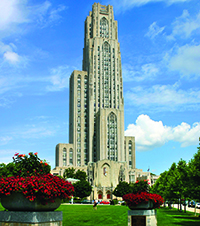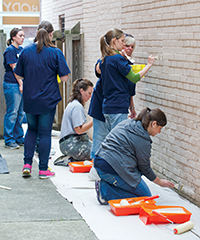The Nordenberg Years to Date: 1995-2013
The Nordenberg Years to Date: 1995-2013
The external review commissioned by the Board of Trustees and publicly released in early 1996 essentially characterized the University of Pittsburgh as an institution of substantial strengths that was adrift and not achieving its full potential. The report issued in the summer of 2012 by the reaccreditation team from the Middle States Commission on Higher Education described Pitt as “an outstanding university”—widely recognized as a “world class research university” and driven by “an unwavering commitment to excellence.” The rise of Pitt within the ranks of the country’s top research universities also has been noted in other places. The following examples provide some sense of the momentum that has been built at the University during the past 18 years.
Growth in Student Body Size and Strength
 From 1995 to the current academic year, Universitywide full-time-equivalent enrollment grew from 27,002 to 32,781, an increase of more than 21 percent, and more than 137,000 Pitt degrees have been awarded since 1995. Applications for admission to the undergraduate programs in Pittsburgh, the University’s largest programs, have increased three-and-one-half times—from a 1995 total of 7,825 to 27,626 for next fall’s entering class. The average SAT score of students who have paid a deposit for next fall’s entering class is 185 points higher than the average of enrolled students in 1995, and 53 percent of those who have deposited ranked in the top 10 percent of their high school graduating classes, compared to 19 percent in 1995.
From 1995 to the current academic year, Universitywide full-time-equivalent enrollment grew from 27,002 to 32,781, an increase of more than 21 percent, and more than 137,000 Pitt degrees have been awarded since 1995. Applications for admission to the undergraduate programs in Pittsburgh, the University’s largest programs, have increased three-and-one-half times—from a 1995 total of 7,825 to 27,626 for next fall’s entering class. The average SAT score of students who have paid a deposit for next fall’s entering class is 185 points higher than the average of enrolled students in 1995, and 53 percent of those who have deposited ranked in the top 10 percent of their high school graduating classes, compared to 19 percent in 1995.
Enviable Levels of Student Achievement
Since 1995, Pitt undergraduates have claimed four Rhodes Scholarships, five Truman Scholarships, six Marshall Scholarships, seven Udall Scholarships, and 41 Goldwater Scholarships. Pitt also is among the nation’s leading producers of Fulbright Scholars, Boren Scholars, Whitaker International Fellows, National Science Foundation Fellows, Critical Language Scholars, and Humanity in Action Scholars.
Enriching the Student Experience
Pitt has been a leader in designing programs to enhance the overall growth experiences of its students. Efforts that stand out include: the launch of the PittArts program, which exposes students to the cultural richness of the greater Pittsburgh region; a pioneering partnership with the Port Authority, giving students fare-free access to public transportation and giving practical meaning to the belief that “the city is our campus”; and the design of the Outside the Classroom Curriculum, providing a structure for students to pursue important learning experiences not tied to classroom activities.
Nurturing Citizenship, Character, and Responsibility.
Pitt students regularly distinguish themselves through their commitment to community. For example, the 2012 Pitt Make A Difference Day involved 3,000 students who traveled to 60 neighborhoods to work on 88 different civic improvement projects. The president of Pitt’s Graduate and Professional Student Government served as the first chair of the Sociable City Initiative, which developed standards for party-hosting responsibility as part of its accountability initiative. In 1995, the highest Pitt priority, from City government and from neighboring residents, was the construction of more on-campus housing. Since then, Pitt has added 2,500 residence hall beds on its Oakland campus.
For example, the 2012 Pitt Make A Difference Day involved 3,000 students who traveled to 60 neighborhoods to work on 88 different civic improvement projects. The president of Pitt’s Graduate and Professional Student Government served as the first chair of the Sociable City Initiative, which developed standards for party-hosting responsibility as part of its accountability initiative. In 1995, the highest Pitt priority, from City government and from neighboring residents, was the construction of more on-campus housing. Since then, Pitt has added 2,500 residence hall beds on its Oakland campus.
Supporting High Levels of Faculty Accomplishment and Impact
The record of honors bestowed upon members of the Pitt faculty is extraordinarily impressive. Faculty members have been elected to membership in such prestigious organizations as the National Academy of Sciences, the Institute of Medicine, the American Academy of Arts and Sciences, the American Association for the Advancement of Science, the Institute for Clinical Investigation, the National Academy of Education, and the National Academy of Nursing. Individual faculty members also have claimed such prestigious awards as the National Medal of Science, the Lasker-DeBakey Clinical Medical Research Award, the MacArthur Foundation’s “genius award,” the Charles S. Mott Prize in cancer research, and the Andrew Mellon Foundation Distinguished Achievement Award for exemplary contributions to humanistic studies, and this list could go on. Equally important is the fact that more junior faculty members continue to claim national awards for their exceptional potential. These include Presidential and National Science Foundation Early Career awards, the Howard Hughes Medical Institute Physician-Scientist Early Career Award, the Pew Foundation Early Career Award, and the Beckman Young Investigator Award.
Reaching the Top Ranks in Research Strength
The strength of Pitt’s research program can best be measured comparatively. The University ranks fifth among all American universities in terms of the federal science and engineering research and development support attracted by members of its faculty—trailing only Johns Hopkins, Washington, Michigan, and Penn and just ahead of UC San Diego, Stanford, Columbia, Wisconsin, and Duke, the fine universities in the second five of this impressive top 10. To climb into a top-five position from a ranking of 24th, which is where Pitt was in 1995, it had to pass each of these fine universities—Arizona, Berkeley, Colorado, Columbia, Cornell, Duke, Harvard, Minnesota, MIT, North Carolina, Penn State, Stanford, UCLA, UC San Diego, UC San Francisco, USC, Washington University in St. Louis, Wisconsin, and Yale—even while each of them was striving to get better.
Building an Inviting Campus Environment Supportive of Living, Learning, and Working
 From 1995 to 2013, and including projects under way but not yet completed, the University has invested more than $1 billion to add 3.6 million additional gross square feet of space. Those projects have helped to dramatically enhance all five Pitt campuses and also have been a very important source of construction jobs in each of the University’s five home communities. It also is instructive to note that the University managed these construction projects, and managed that 3.6 million square feet of additional space, with a facilities staff that is just about the same size as it was in 1995. Certain other signature initiatives from this same period did not involve the addition of facilities space but were transformational, not only for Pitt, but also for the community. Two key examples would be the cleaning and repair of the exterior of the Cathedral of Learning and the construction of Schenley Plaza.
From 1995 to 2013, and including projects under way but not yet completed, the University has invested more than $1 billion to add 3.6 million additional gross square feet of space. Those projects have helped to dramatically enhance all five Pitt campuses and also have been a very important source of construction jobs in each of the University’s five home communities. It also is instructive to note that the University managed these construction projects, and managed that 3.6 million square feet of additional space, with a facilities staff that is just about the same size as it was in 1995. Certain other signature initiatives from this same period did not involve the addition of facilities space but were transformational, not only for Pitt, but also for the community. Two key examples would be the cleaning and repair of the exterior of the Cathedral of Learning and the construction of Schenley Plaza.
Fostering Higher Levels of Athletic Success
In 1995-96, Pitt’s football team had a record of 2-9, its men’s basketball team had a record of 10-17, and the Univesity’s women’s basketball team had a record of 6-24. Since then, football has posted a winning record overall and has played in 11 bowl games, men’s basketball has built one of the top winning percentages in the country and played in 11 straight NCAA tournaments, and women’s basketball advanced to three NCAA tournaments, including two Sweet Sixteen berths. Though more work lies ahead, with Pitt’s move to the Atlantic Coast Conference and the University’s development of top-flight facilities, better days should lie ahead. Meanwhile, Pitt student-athletes continue to distinguish themselves as students, with 350 of them honored this spring for achieving a grade-point average of at least 3.0.
Engaging With the Community
 Over the course of the past 18 years, Pitt has become a model of community engagement—making its expertise available in ways that are consistent with the University’s teaching and research missions. As one sign of its impact, Pitt was the top-ranked public university in the most recent edition of Saviors of Our Cities: A Survey of Best College and University Civic Partnerships. The University also has been the recipient, for three consecutive years, of the Good Neighbor Award from the United Way. And most recently, Pitt was recognized by President Obama on the 2013 National Honor Roll for extraordinary and exemplary community service contributions.
Over the course of the past 18 years, Pitt has become a model of community engagement—making its expertise available in ways that are consistent with the University’s teaching and research missions. As one sign of its impact, Pitt was the top-ranked public university in the most recent edition of Saviors of Our Cities: A Survey of Best College and University Civic Partnerships. The University also has been the recipient, for three consecutive years, of the Good Neighbor Award from the United Way. And most recently, Pitt was recognized by President Obama on the 2013 National Honor Roll for extraordinary and exemplary community service contributions.
Invigorating and Transforming the Regional Economy
The education and health services supersector, with UPMC and Pitt sitting at its heart, is the largest source of employment in the Pittsburgh metropolitan area. It is the only sector that has added jobs every year since 1995, and the sector now is responsible for more than one out of every five local jobs. University research has been a key source of economic growth, and since 1995, Pitt has attracted more than $9 billion of sponsored research support into this region. Pitt’s research, combined with Carnegie Mellon’s, also has provided the foundation for such future-oriented technology-based economic development initiatives as the Pittsburgh Digital Greenhouse, the Pittsburgh Life Sciences Greenhouse, the Pittsburgh Robotics Foundry, and the Technology Collaborative. The University also created its own Office of Technology Management, which is generally regarded as one of the country’s best.
Attracting Ever Higher Levels of Philanthropic Support
In 1995, Pitt attracted less than $40 million in private philanthropy. The University now has raised more than $100 million in cash received per year for eight straight years. Notably, that includes the years of the Great Recession. Through generous gifts received from more than 188,000 donors as part of its $2 billion capital campaign, the University was able to create more than 1,500 new endowments, including more than 600 for student scholarships and fellowships and nearly 150 for new faculty chairs and professorships.
General Measures of Momentum
The University’s endowment has grown by 6.5 times, from $463 million in 1995 to $2.99 billion at the end of the last quarter, and its net assets have almost quadrupled, from $997 million in 1995 to just under $3.8 billion in that same period. The University’s employee base has risen from 9,671 in 1995 to 13,372 in 2013—an increase of more than 38 percent and more than 3,700 employees—and that is after the implementation of a voluntary early retirement program. Pitt also just received a long-term ratings upgrade from AA/stable to AA/positive from Standard & Poor. This is particularly noteworthy given negative assessments of the general outlook for higher education that have been issued in recent months.
Other Stories From This Issue
On the Freedom Road

Follow a group of Pitt students on the Returning to the Roots of Civil Rights bus tour, a nine-day, 2,300-mile journey crisscrossing five states.
Day 1: The Awakening
Day 2: Deep Impressions
Day 3: Music, Montgomery, and More
Day 4: Looking Back, Looking Forward
Day 5: Learning to Remember
Day 6: The Mountaintop
Day 7: Slavery and Beyond
Day 8: Lessons to Bring Home
Day 9: Final Lessons

